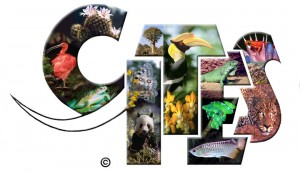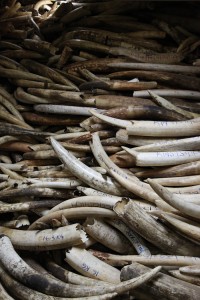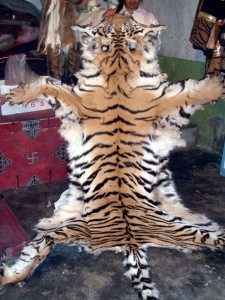Ready for CITES – ruffling feathers and on the right track!


Hello! I’m Shruti, EIA’s latest newbie in its growing team of incredible people from diverse backgrounds and skills. I joined last month as a Wildlife Campaigner and it has already been an exciting and busy few weeks!
At present, EIA’s wildlife campaigns are focused on investigating and campaigning to end the illegal trade of products from key species such as tigers and other Asian big cats, elephants and cetaceans, and protecting their habitats; my work has been focused on Asian big cats and elephants. Our campaigns span the world and involve advocacy at both national and international forums. At the international level, for almost three decades now EIA has been actively engaged in advocating the effective implementation and enforcement of a key international legal instrument, i.e., the United Nations Convention on International Trade in Endangered Species of Wild Fauna and Flora (CITES) which is an agreement among 175 countries that regulates international trade in wildlife and their products.
 This month we are gearing up to attend one of the most significant meetings this year for international wildlife conservation, the 62nd meeting of the CITES Standing Committee in Geneva from July 23-27, 2012. The Standing Committee is an important body within the CITES framework as it provides the member countries (Parties) with policy guidance in the implementation of CITES.
This month we are gearing up to attend one of the most significant meetings this year for international wildlife conservation, the 62nd meeting of the CITES Standing Committee in Geneva from July 23-27, 2012. The Standing Committee is an important body within the CITES framework as it provides the member countries (Parties) with policy guidance in the implementation of CITES.
In preparation for this month’s meeting, we have briefed the CITES Parties on EIA’s positions regarding several key questions which will be hotly debated at the meeting, such as prohibiting all trade in ivory, shutting down tiger farms and ensuring Parties comply with their reporting obligations. This meeting is an important precursor for the next CITES Conference of Parties (the meeting of all Parties to the Convention which next takes place in March 2013) because the Standing Committee’s recommendations will likely influence the resolutions and decisions adopted by the Parties.
 EIA’s Briefing Paper for the 62nd meeting of the CITES Standing Committee is available here. Since 1984, EIA has played a crucial role in exposing and campaigning against illegal trade in wildlife and our presence at the meeting is formidable for those actors who are not taking effective steps to curb illegal trade in wildlife. In fact, things can get very dramatic. In last year’s meeting of the Standing Committee, NGOs, including EIA, were voted out of the room! It turned out certain nations wanted to discuss the findings of EIA’s ivory investigations privately (read without EIA in the room).
EIA’s Briefing Paper for the 62nd meeting of the CITES Standing Committee is available here. Since 1984, EIA has played a crucial role in exposing and campaigning against illegal trade in wildlife and our presence at the meeting is formidable for those actors who are not taking effective steps to curb illegal trade in wildlife. In fact, things can get very dramatic. In last year’s meeting of the Standing Committee, NGOs, including EIA, were voted out of the room! It turned out certain nations wanted to discuss the findings of EIA’s ivory investigations privately (read without EIA in the room).
At the meeting, I will also be interested in observing the political dynamics at play and hearing the views of individual nations on key issues. For instance, which nations are playing a leadership role in condemning the poaching of elephants and demanding stricter measures against ivory trade? In particular, I am interested in the views and questions posed by the delegation from my home country of India – what is India’s position on the trade in China of tiger skins and bones obtained from the massacre of the fast-dwindling tiger populations in India? These are critical issues I hope will be urgently addressed by the CITES Parties.
All in all, I am excited to attend the meeting this year and to join EIA front line in advocating effective implementation and enforcement of CITES!
In retrospect, my motivation to become an environmental lawyer and campaigner was influenced by a number of experiences and activists in India and abroad. Growing up in India during a time when the country underwent drastic changes from rapid economic development made me acutely aware of the often irreversible environmental impacts of reckless human actions. At the same time, working with many environmental groups and activists also made me recognise the power of grass root groups, be it a single person or small group of activists, in challenging vested interests for upholding the long-term protection of our environment and wildlife.
I studied law at the National University of Juridical Sciences in India and followed up by completing my master of laws from Columbia Law School in New York. At both law schools, I focused my attention on environmental and wildlife issues. Prior to joining EIA, I worked for about two years at Meyer, Glitzenstein & Crystal (MGC), a public interest law firm in Washington DC renowned for pioneering key litigation for the protection of wildlife under the US Endangered Species Act. At the firm, I worked with a team of brilliant lawyers in advising non-governmental client organisations on a variety of wildlife issues. I have also had the opportunity to complete internships with organisations such as the United Nations Environment Program (UNEP), Environmental Defense Fund, WWF India, International Environmental Law Research Centre and Environment Support Group.

(c) EIA
These experiences gave me an opportunity to engage with governments, scientists, industry, lawyers, policy experts and communities on issues that society grapples with routinely – what must governments do to protect wildlife?; how do we stop environmental crime?; how do we change industry’s unsustainable impacts?; and how can communities help in protecting local resources?
At times, I cannot escape the utter frustration of the difficult, and at times heart-wrenching, nature of the issues we work on – how do you stop tigers being butchered for home decor or elephants being killed for ivory chopsticks?; when will governments realise that action not taken now might mean a species lost forever?; when will society recognise that you cannot put a price-tag on nature?
At EIA, I am looking forward to doing my very best in fighting these issues, highlighting the urgency in protecting certain species, exposing perpetrators of environmental crime and pressing relevant actors for positive action. I don’t expect this to be an easy challenge and I reckon there will be many people along the way who will not be pleased with what I have to say, but hey … as someone I regard very highly once told me, if you’re ruffling enough feathers, it must be worth it and you’re on the right track. So, game on!